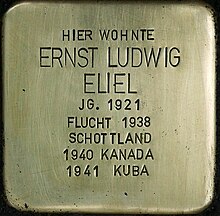Ernest L. Eliel
Ernest Ludwig Eliel , originally Ernst Ludwig Eliel, (born December 28, 1921 in Cologne , † September 28, 2008 in Chapel Hill , North Carolina ) was an American chemist ( stereochemistry , organic chemistry ).
Ernst Eliel was born as the youngest son of the Cologne lawyer Oskar Eliel and his wife Luise, b. Tietz born in Cologne. Eliel fled Germany from the Nazis via Scotland , Canada and Cuba , where he began his studies at the University of Havana , where he received his doctorate in chemistry in 1946 . Then he went to the USA and received his PhD in organic chemistry from the University of Illinois in 1948 with Harold Ray Snyder . After that he was first an instructor and then a professor at the University of Notre Dame, where he was head of the chemistry department from 1964 to 1966, and from 1972 he was William Rand Kenan Jr. Professor at the University of North Carolina at Chapel Hill.
He was best known for research on stereochemistry and was considered an authority in the USA with an influential textbook and standard work that appeared in 1962. He dealt with conformational analysis, asymmetric catalysis , organic sulfur compounds , chemistry of heterocycles and carbanions and nuclear magnetic resonance . With Horst Kessler and Gerhard Binsch he introduced the term topomerisation and topomer in 1971 .
In 1997 he received the NAS Award for Chemistry in Service to Society and in 1995 the Priestley Medal . He was a Fellow of the National Academy of Sciences , the American Association for the Advancement of Science (whose chemistry section he chaired 1991/92), the Royal Society of Chemistry and the American Academy of Arts and Sciences (1980). He received the Lavoisier Medal of the French Chemical Society in 1968 , the Pimentel Prize in 1995 and was a Guggenheim Fellow at Stanford and Princeton in 1975/76 and at Duke University in 1983/84. Eliel was President of the American Chemical Society in 1992 . In 1981 he was CV Raman Visiting Professor in Madras.
Eliel died in 2008 at the age of 86 and was buried in the Judea Reform Congregation Cemetery in Chapel Hill Township. He left his wife Eva nee Black and two daughters.
On September 25, 2019, in memory of Ernest Eliel and his parents Oskar and Luise Eliel in Cologne-Braunsfeld , three stumbling blocks were laid in front of the family house on the initiative of the German Alpine Club, Rhineland-Cologne section .
Fonts
- Stereochemistry of Carbon Compounds, McGraw Hill 1962
- German edition: Basics of stereochemistry, Birkhäuser 1972, 2nd edition 1977
- with Samuel H. Wilen: Stereochemistry of Organic Compounds, Wiley 1994
- German translation: Organic Stereochemistry, Wiley-VCH 1998 (translated and edited by Henning Hopf , Johann Mulzer ), and before that as Stereochemistry of Carbon Compounds , Weinheim: VCH 1966
- with Samuel H. Wilen, Michael P. Doyle: Basic organic stereochemistry, Wiley 2001
- Conformational Analysis, American Chemical Society 1981 (first Interscience 1965)
- From Cologne to Chapel Hill, American Chemical Society 1990 (autobiography)
Web links
- Obituary, UNC ( Memento from August 27, 2014 in the web archive archive.today )
Individual evidence
- ^ Biographical data, publications and academic family tree of Ernest Ludwig Eliel at academictree.org, accessed on January 1, 2018.
- ↑ Career data based on American Men and Women of Science , Thomson Gale 2004.
- ↑ Binsch, Eliel, Kessler, A Nomenclature for Intramolecular Exchange Processes, Angewandte, Chemie, Volume 83, 1971, p. 618.
- ^ Tomb in the Find a Grave database . Retrieved November 13, 2019.
- ↑ Laying of stumbling blocks for Oskar, Luise and Ernst Eliel. German Alpine Club, accessed on November 11, 2019 .
| personal data | |
|---|---|
| SURNAME | Eliel, Ernest L. |
| ALTERNATIVE NAMES | Eliel, Ernest Ludwig (full name); Eliel, Ernst Ludwig |
| BRIEF DESCRIPTION | American chemist (stereochemistry, organic chemistry) |
| DATE OF BIRTH | December 28, 1921 |
| PLACE OF BIRTH | Cologne |
| DATE OF DEATH | September 28, 2008 |
| Place of death | Chapel Hill , North Carolina |
